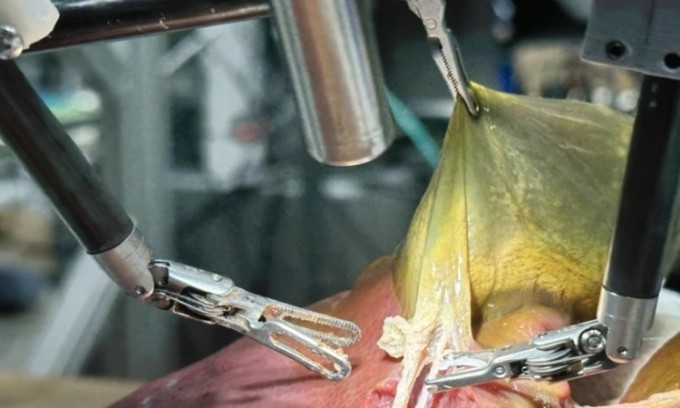Researchers at Johns Hopkins University trained a robot to successfully perform gallbladder removal surgery on real patients with proficiency comparable to that of experts.

A robot trained on surgical videos has performed a lengthy gallbladder removal without human assistance. The robot operated on a real patient for the first time. Throughout the procedure, it responded to and learned from the expert team’s commands, much like a novice surgeon working with a human instructor. The robot calmly performed the procedure through trials with the expertise of a skilled surgeon, even in the unexpected situations typically encountered in an emergency.
The research, led by experts at Johns Hopkins University, is a breakthrough in the field of surgical robots, allowing robots to operate with human-like mechanical precision, adjustability and understanding. Medical roboticist Axel Krieger and his colleagues published the results of the research on July 9 in the journal Science Robotics.
In 2022, Krieger’s Intelligent Autonomous Surgical Robot (STAR) performed the first automated laparoscopic surgery on a live pig. But that robot required special tissue marking, operating in a tightly controlled environment, and following a rigid pre-planned surgical plan.
But the Transformer-Hierarchy Surgical Robot (SRT-H) actually performs the surgery, adjusting to individual anatomical features in real time, making decisions on the fly, and adjusting itself when things don't go as planned. Built with the same machine learning architecture as ChatGPT, the SRT-H is also interactive, responding to voice commands like "grab the tip of the gallbladder" and adjusting to requests like "move your left arm a little to the left."
Last year, Krieger’s team used an AI model to train a robot to perform three basic surgical procedures: handling a needle, lifting body tissue, and sewing sutures. Those tasks take seconds, while removing a gallbladder is much more complex, a sequence of 17 operations that takes several minutes. The robot must precisely locate tubes and arteries, place clamps, and cut parts with scissors.
The SRT-H learned to perform gallbladder surgery by watching videos of surgeons at Johns Hopkins performing the surgery on pig cadavers. The team augmented the training with images and captions describing the procedure. After watching the videos, the robot performed the surgery with 100% accuracy. Although the robot took longer to perform the surgery than a human surgeon, the results were comparable to those of an expert surgeon.
The robot performed the surgery flawlessly under heterogeneous anatomical conditions and unexpected situations, such as when the team changed the robot's starting position or added a blood-like dye that changed the shape of the gallbladder and surrounding tissue.
Next, the team wants to train and test the system with more types of surgeries and expand its capabilities to perform fully automated surgery.
Source: https://baolaocai.vn/robot-ai-tu-dong-giai-phau-100-post648653.html




![[Infographic] Phong Nha-Ke Bang National Park and Hin Nam No National Park - The first transboundary world heritage of Vietnam and Laos](https://vphoto.vietnam.vn/thumb/1200x675/vietnam/resource/IMAGE/2025/7/14/e6edaedb8e7345e484b074affac0739b)























































![[Maritime News] Treasury Department Targets Diverse Networks Facilitating Iran's Oil Trade](https://vphoto.vietnam.vn/thumb/402x226/vietnam/resource/IMAGE/2025/7/14/43150a0498234eeb8b127905d27f00b6)






































Comment (0)